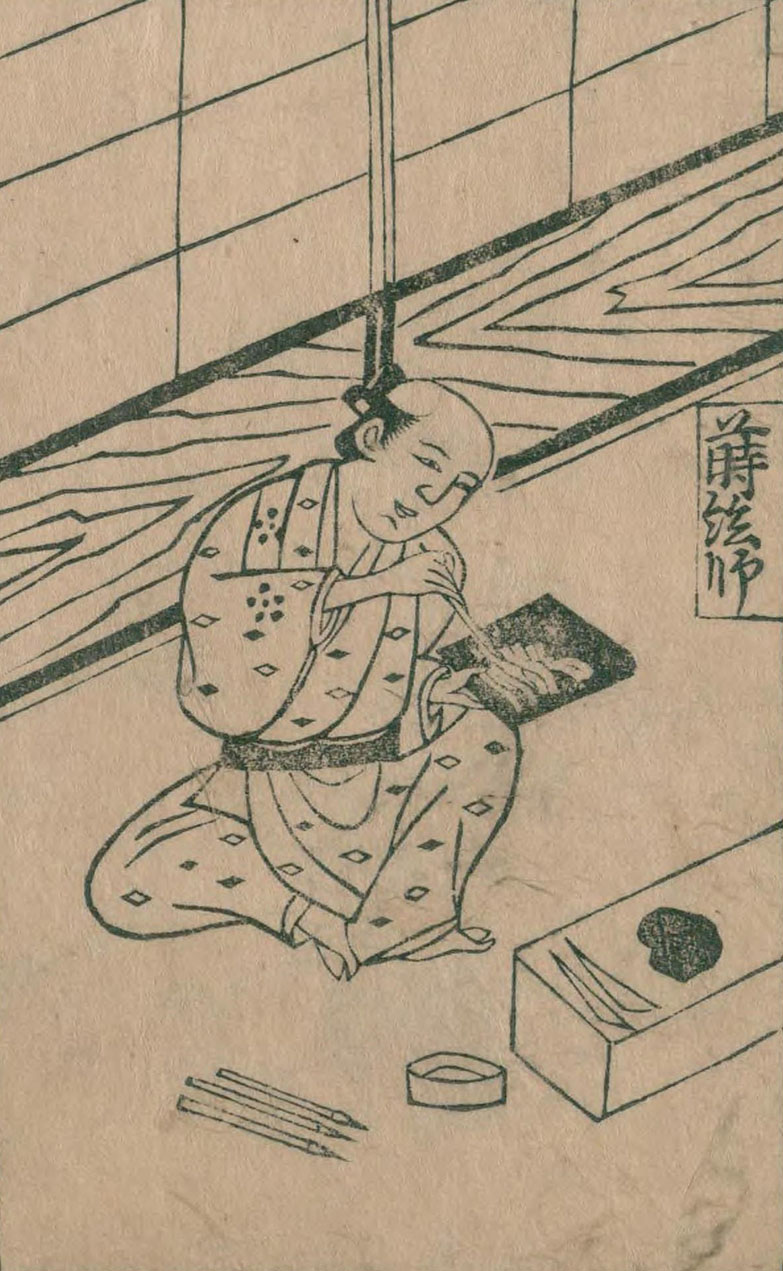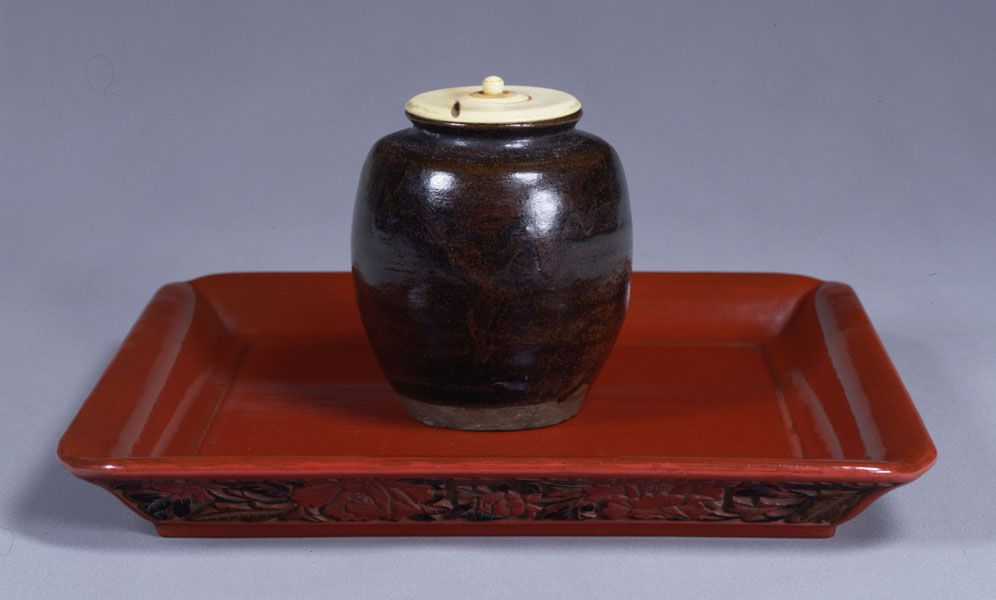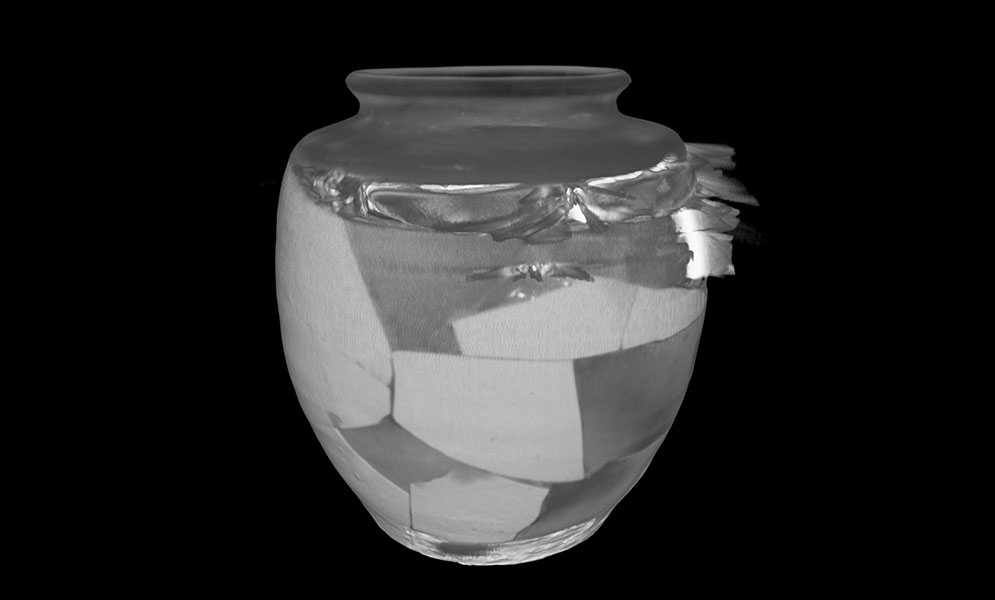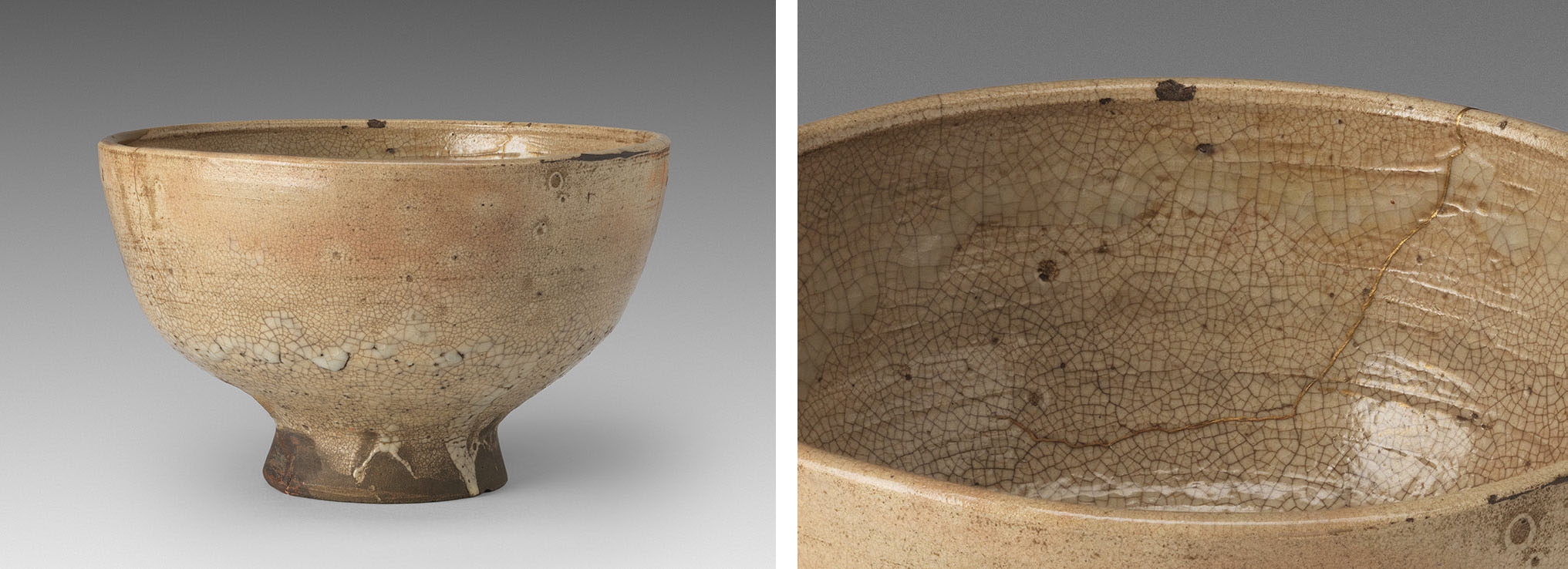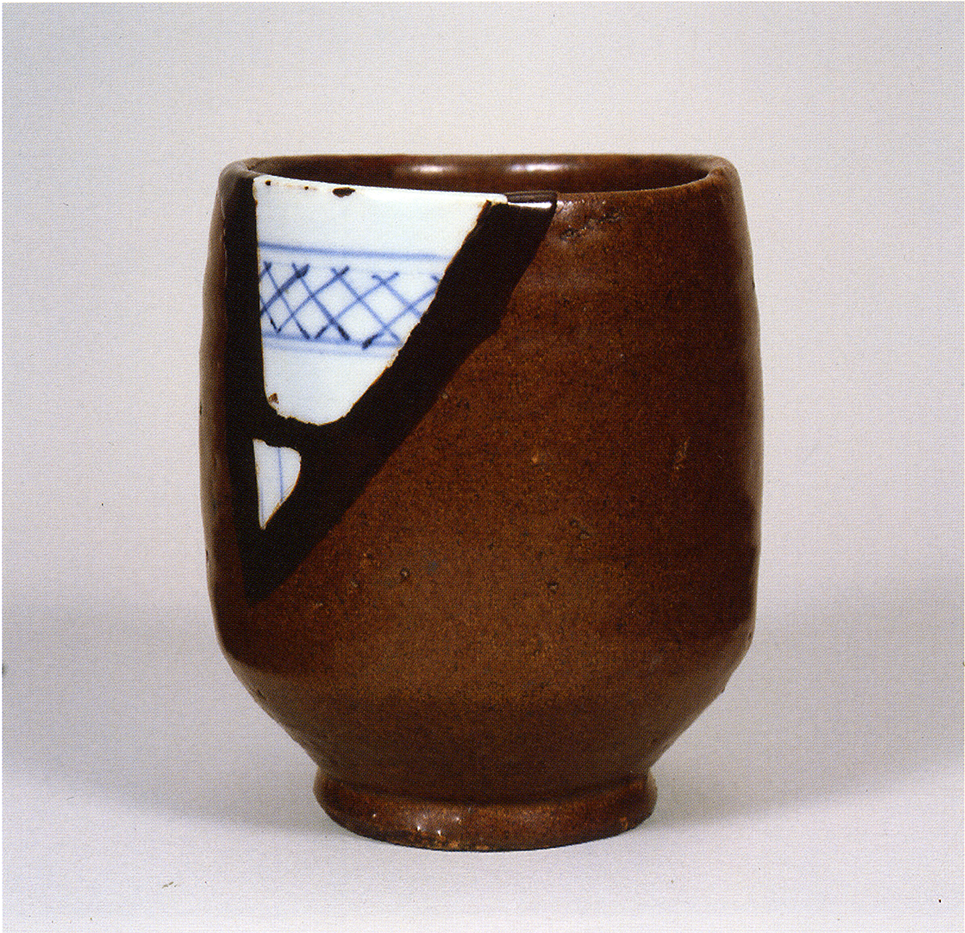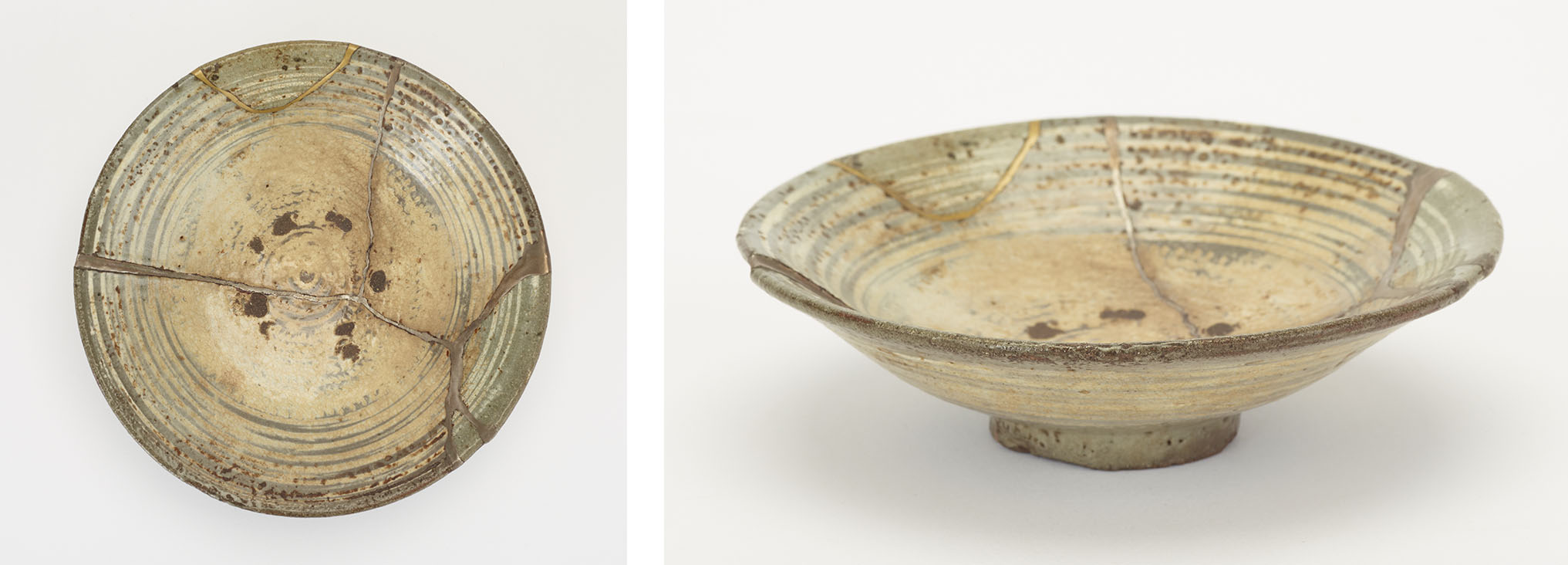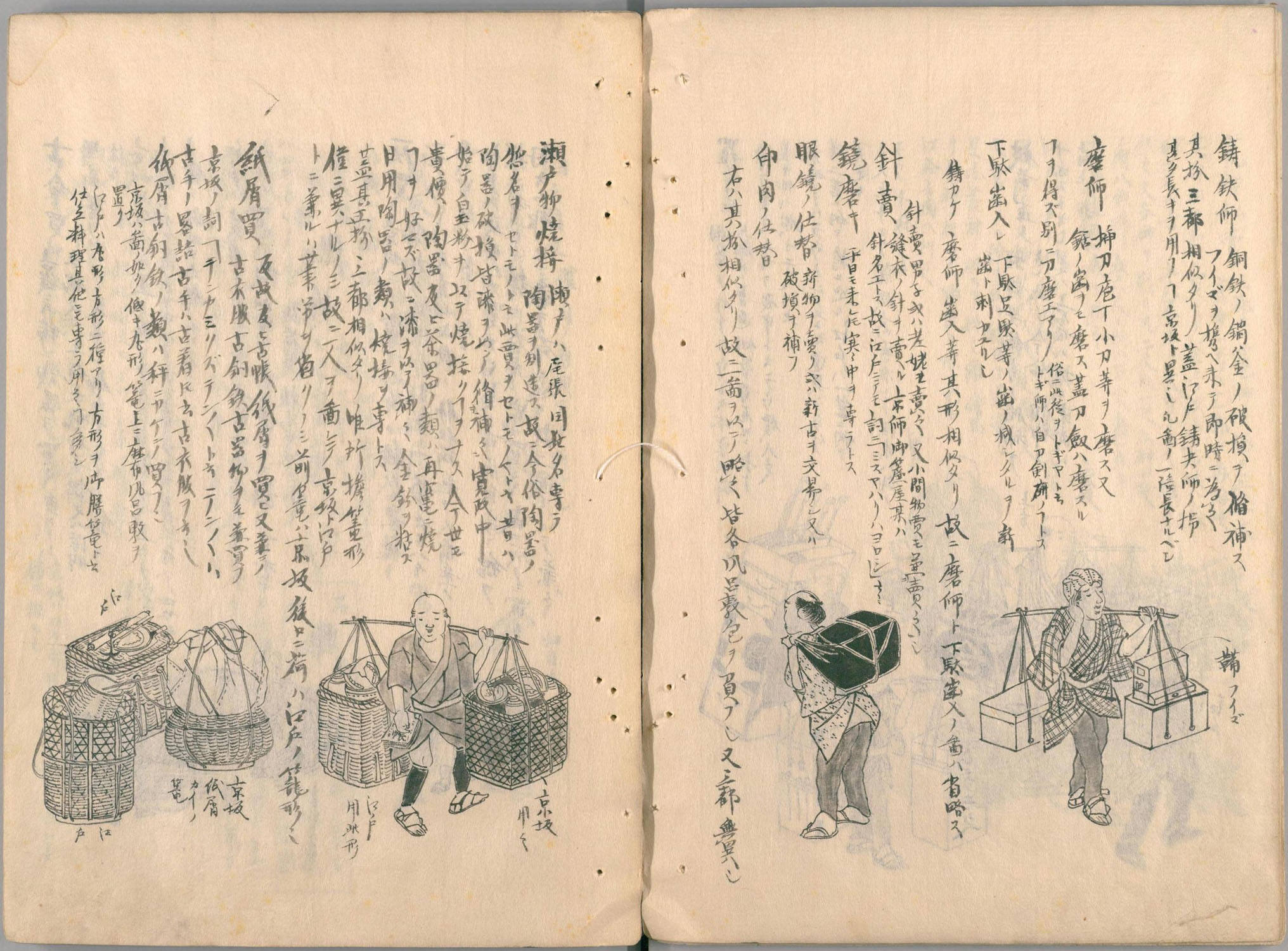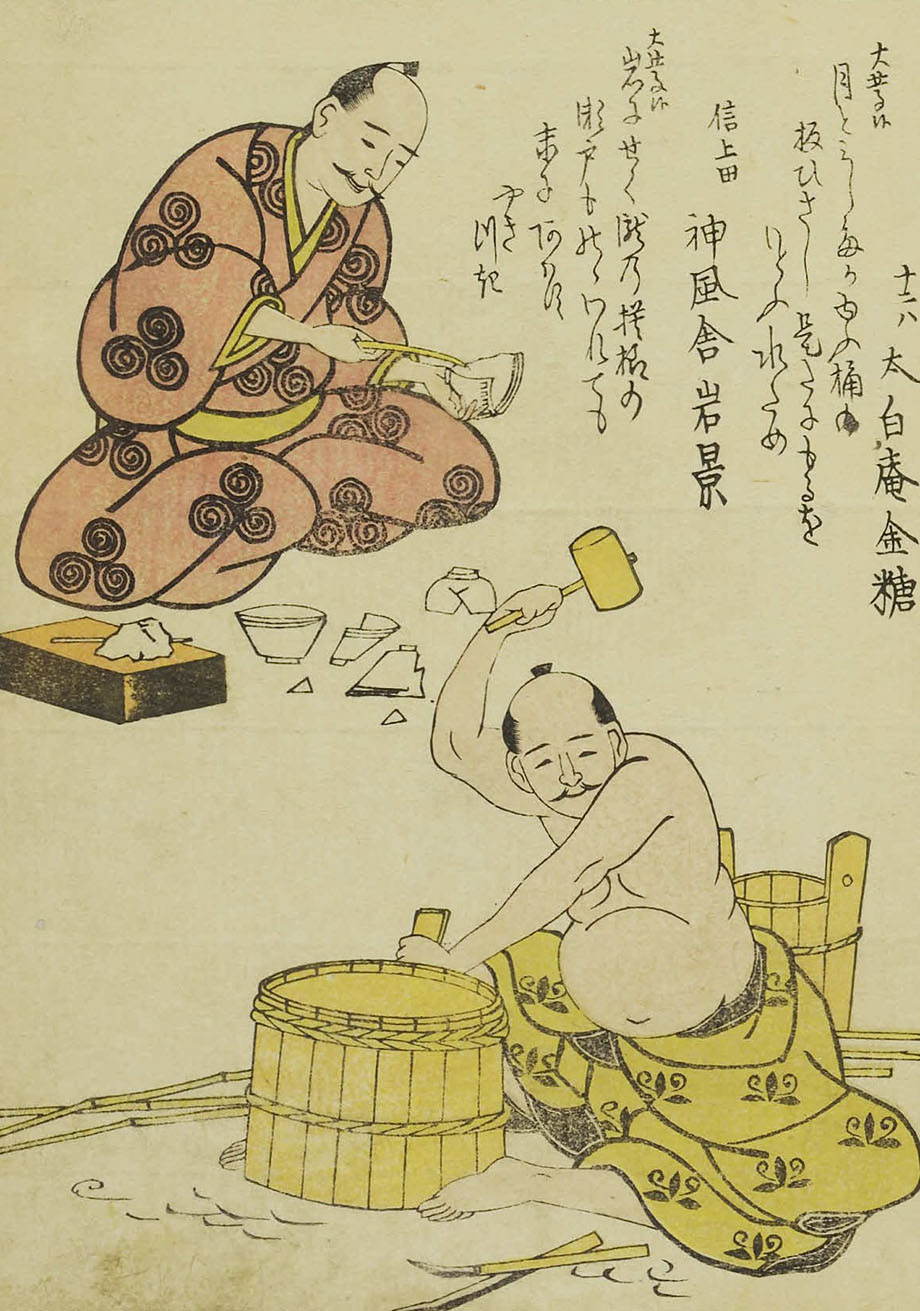Introduction
In Japan’s Momoyama and Edo periods (1573–1868), when a cherished tea ceramic was broken, its user was faced with some choices in determining the damaged ceramic’s future. One way was to have it repaired, bringing the bowl back to its functional state, and the other option was to terminate its life as a usable item. The historical ceramic vessels discussed in this essay were saved because their owners chose to have them repaired so they could maintain them. Their shattered, chipped, or cracked bodies were reinvented through different mending styles, some more visible than others. They were often mended with urushi 漆 (lacquer-tree sap). Urushi was dusted with powdered precious metal in some cases, transforming the refurbishment into an ornamental addition to its body. While written accounts describing individual restoration cases rarely exist, the materials and design choices employed to rescue the vessels allow us to think about what it means to be original, authentic, or perfect.
The method of visible restoration, often called kintsugi 金継ぎ (gold joinery), has become a trend today, stimulating creative minds both inside and outside Japan in the realms of art and design. Although a convenient umbrella term, I hesitate to use the word kintsugi in discussing historical examples because the term does not adequately cover the full range of mending techniques and materials.1 If you search kintsugi on the Internet, there is no shortage of contemporary works that have appropriated the visual vocabulary of mended tea ceramics. In recent years, this restoration component, with enhanced traces of past damage and repair, has been a theme for exhibitions. It also has been further interpreted by psychologists as a metaphor for overcoming traumatic experiences. Amid this popularity of kintsugi, I attempt to unfold the multilayered meaning of this traditional mending method and its place in our contemporary time.
Authentic, Original, and Perfect
In light of recent scientific findings of past restorations and their visible or ornamental repairs, the mended ceramics discussed below prompt us to ponder the definition of what an authentic, original, or perfect object is, and indeed to wonder how often such conditions align. In museums, most of a collection stays in storage, and ceramics are no exception. Some of them remain undisplayed for decades due to varying reasons, the first being their structural condition: if displaying an object harms its structure, the issue needs to be addressed before it goes on display. The second factor is its appearance: in an ideal world, art museums attempt to display the best examples of an artist, a school, or a type.2 This issue is also linked to a third concern, which deals with the authenticity of objects. The definition of an object’s authenticity ranges widely, but for an object to be perceived as authentic, it needs to be original (that is, in its physical native form), have historical significance, and have a direct connection to its creator.3 Its functionality is also an essential factor.4 Therefore, when a work of art has been heavily retouched or compensated with replacements, the object’s legitimacy is reassessed.5 When a past restoration campaign becomes an obstacle to displaying a work, a conservator might try to remove or rework the treatment to bring it as close to its original form as possible with minimal discernible traces of conservation. This principle stems from one overarching standard: the less visible the restorations are, the better.
Fascinatingly, mended ceramics, especially those featuring enhanced traces of repair, challenge some of these criteria. The restorations are not only visible, but the repairs have also become ornamental elements, sometimes altering their appearance significantly. Some examples may have lost a substantial portion of their original bodies, and the loss is filled with supplemental elements, which calls into question issues of authenticity. Simultaneously, however, the three factors linked to the definition of authenticity—historical significance, functionality, and connection to creators—urge us to reject a binary sense of authenticity and to acknowledge that mended ceramics with their visible repairs and added elements represent intriguing afterlives post-production. We also need to consider the users because they matter when we think about ceramics’ functionality. Past restoration campaigns embedded in their bodies demonstrate that mending is a crucial part of their lives as functional and valuable objects, because without these repairs, they would not have retained their roles as utensils or decorative objects, and possibly not have survived. The careful joining of broken pieces reinvents a ceramic’s body, marking a moment of rupture and revival,6 and directs us to think about what it means for them to be extant, to echo Halle O’Neal’s prompt in the introduction to this issue. Reconstructing the full provenance of mended ceramics and their process of transformation may be unattainable, because many of them have been detached from their written records, or the stories they have accumulated are anecdotal.7 However, the existence of the patched body itself is proof that they were, at least at one point in their previous lives, functioning and valued objects considered significant enough to be restored instead of being thrown away. Furthermore, the users of some ceramics named them, signaling their affection for their belongings.
Mending in the Momoyama and Edo periods (1573–1868)
Until the 1790s, the main adhesive used to repair damaged ceramics was urushi.8 Urushi is tree sap collected from the urushi tree, a long-standing medium used in Japan since the early Jōmon period (ca. 5000–2500 BCE).9 During the Momoyama and Edo periods (1573–1868), the mending of damaged ceramics using urushi was likely to have been common practice.10 Lacquerers, or nushi 塗師 and makie-shi 蒔絵師 (fig. 1), would have done the restorations, as urushi requires specialized material knowledge,11 and they used a decoration technique of adding powdered gold and other precious metals, called makie 蒔絵 (sprinkled picture). Restoring ceramic vessels may have involved multiple hands, but the identity of the lacquerers remains mostly unrecorded.12
It is difficult to construct a definitive explanation of how lacquer and powdered metals were used for mending in the historical context, or how they were viewed before the Meiji period (1868–1912). Although occasional accounts are found referring to famed tea masters’ preferences regarding damaged and repaired (hence “imperfect”) objects, they tend to be written posthumously.13 And while abundant examples of restored utensils for chanoyu 茶湯 (lit., “hot water for tea”; a choreographed way of preparing and consuming tea) exist, tea practitioners rarely recorded stories of restoration. One thing to note is that the term kintsugi, which we often use today as an umbrella term referring to the visible mending of ceramics with gold, does not seem to appear in the tea diaries and records of famous objects, or meibutsu 名物.14 The repairs were noted as tsugi 継 (join, patch) or tsukuroi 繕 (repair), but the restoration details were not recorded to the extent of other kinds of information.15
The word tsukuroi indicates that visual quality was a concern in repairing. Its verb form tsukurou is found, for instance, in the 191st chapter of Tsurezuregusa 徒然草 (Essays in idleness), in which Yoshida Kenkō 吉田兼好 (ca. 1283–1350) writes “kagami torite, kaonado tsukuroite” 鏡取りて、顔などつくろひて (mirror in hand, touches up her make-up).16 The term continued to refer to both mending and visual improvement in subsequent centuries. In the case of ceramics used for chanoyu, Itō Yoshiaki states that restoring them fulfilled two goals: rebuilding their physical structure and reclaming their value.17 To bring them back to a functional and presentable state, their owners had some design choices. Perhaps the dusting of precious metal powder onto urushi, or introducing a new element to the body during repair, was an expression that enhanced the original body’s beauty.18 This resonates with the importance of visual and aesthetic quality when refurbishing and repurposing Buddhist icons, as Benedetta Lomi addresses in her article. It also links to the practice of scroll remounting, in which mounted textiles supplement visual elements for a painting, as Tanya Ueda discusses.
The restoration process began by assessing the level of damage to determine the treatment plan. Small chips and cracks could be filled with urushi.19 When the damage was more severe, such as a segment being separated from the body, the ceramic was reconstructed by adhering the pieces together with different types of urushi.20 Urushi was used to make repairs both invisible and visible, and powdered precious metal or colorants were added to make the mending ornamental or to re-create the desired color. If a body lost a significant piece, the loss could be filled with supplemental elements such as wood or shards recycled from a different ceramic piece.21
When the ceramic tea container named Shōzan 松山 (lit., “Pine Mountain”; fig. 2a) shattered into pieces, the goal of the repairs was to reconstruct it to look identical to its original form and restore its glory as a valued karamono 唐物 (Chinese luxury item). Karamono were the most revered and sought-after group of objects since the late Kamakura period (1185–1333). Created in China in the thirteenth century, this katatsuki 肩衝 (with shoulder)-type tea container features square shoulders and a rich, dark brown body with a slightly swelling belly. Itō Yoshiaki has given an account of this highly valued object, which was recorded as meibutsu and ōmeibutsu 大名物 (grand famous object).22 According to its provenance noted on its storage box, it broke apart in the fire of 1829 in Edo. The owner at that time, Naraya Genjirō 奈良屋源次郎, collected the shards from the ashes after the fire. His acquaintance Kohitsu Ryōban 古筆了伴 (1790–1853) took the remains and consulted with Tanimatsuya Sōchō 谷松家宗潮 (d. 1853), a tea-utensil dealer, because Sōchō had recorded Shōzan’s bodily traits, including its glaze and weight, before the tragic fire. With the recommendation of Sōchō, an Osaka-based lacquerer named Kawabata Konsa 川端近佐 (1818–1889) joined the shards, filled in the lost parts with wood, and coated the surface with lacquer to make the restored body look identical to its original form. He even replicated its glaze through the use of lacquer.
Tea caddy named Shōzan, katatsuki (shouldered) type, China, 13th century. Glazed stoneware; h. 8.2 cm. Tokyo National Museum. ColBase, https://colbase.nich.go.jp/collection_items/tnm/TG-2928?locale=ja
A recent scientific study verified the rebirth story of Shōzan. As described on its box, X-ray scans showed that the body under the lacquered surface is constructed of ceramic, wooden pieces, and thin pieces of lead, to replicate its form and weight (fig. 2b).23 These findings lead us to wonder if the tea container is authentically original or not. From a scientific perspective, it may not be fully authentic because about one-half of its body is a later reconstruction with added new elements, and its exterior, which looks like glaze, is actually lacquer. However, from a tea connoisseurs’ viewpoint, its authenticity does not appear to have been a problem because it still retains original parts that contain its users’ memories and its value as a highly appraised karamono. Its body appears identical to its original form, and its functionality, as well as the haptic experience it offers, has been restored. Physically transformed and patchworked in an “invisible” manner, Shōzan has reclaimed its aura as an object of significance, which continued to appear on meibutsu records, including the Taishō meikikan 大正名器鑑 (Taishō famous utensil catalog), published between 1921 and 1926.24
X-ray image of Shōzan (fig. 2a). In the collection of the Tokyo National Museum. Image courtesy of the Kyushu National Museum
As opposed to the re-creation of Shōzan, whose purpose was to reinvent its body as if nothing had happened, the gold or colored lacquer used on other mended ceramics make their restorations visible. There is a wide-ranging style within the group of visibly mended ceramics, and some are more noticeable and ornate than others. For instance, the small restoration along the lip of the Karatsu 唐津-type tea bowl (figs. 3a, b) does not stand out as a striking transformation. Karatsu-type ceramics such as this bowl were created in Kyushu by incorporating Korean ceramic design and techniques. The small brownish-red patch has aged with the bowl through repeated use, making the reinforcement inconspicuous while conveying the passage of time. Although the colored lacquer is an added element, it does not distract the viewer’s attention from looking at the bowl. Similarly, the mended seams on the Gohon 御本-type glazed stoneware bowl (fig. 4a), which are embellished with gold, discreetly show added elements because the fine golden lines blend with its pinkish white crackle glaze. Gohon-type bowls were custom-made in Korea for Japanese clients who desired Korean vessels for chanoyu.25 Although not likely a recorded meibutsu, the repair was done with care, minimally impacting the original appearance. The golden filling is smoothly level with the ceramic body, providing the same tactile experience that the original body had before its damage (fig. 4b). The gently glistening golden veins suggest an intention to bring the bowl back to its fully functional state while adding a restrained ornamental effect.
Fine golden lines are also found on the sixteenth-century Japanese glazed stoneware tea bowl (fig. 5a), which demonstrates the decorative effects of mending. Looking at the bowl from above, a fine golden vein runs across the body and splits into three, like a stream branching out in three directions (fig. 5b). Close examination reveals that the takamakie 高蒔絵 (relief-sprinkled picture) technique was used to add relief-like decoration along the lip during restoration where small parts were lost (fig. 5c). A lacquerer applied this technique to create small golden flower motifs on the surface, which was dusted with silver powder (now tarnished).26 These two ornamental restorations were done, at least two different times, demonstrating the care that the bowl received.27 The repairs stand out pleasantly, as they complement the original body with a color temperature and composition that resembles the glaze. Although no longer in its original, undamaged form, the bowl regained its functionality and acquired a renewed body, remarking the owner’s affection toward the bowl.
Visible repairs using gold can create the most striking visual statements, such as inviting the viewer to imagine a landscape on the small body of the tea bowl. Seppō 雪峰 (snowy peak) is a Raku 楽-type, hand-built, and glazed stoneware bowl with dramatic breakage and gold lacquer repairs. Raku-type bowls are one of the most celebrated and commonly used bowls in chanoyu since the sixteenth century. On the pinkish-red round body of Seppō, the white glaze has the appearance of snowy mountain peaks, as the bowl’s name suggests. Breaking the quiet mountainscape are dynamic and bold golden fillings that cut through the scenery like sudden lightning or the rushing water of waterfalls.28 This dynamic bowl was created by Hon’ami Kōetsu 本阿弥光悦 (1558–1637), a multitalented artist who was deeply involved in the arts and culture of Kyoto, where chanoyu held a central place.29 Tradition tells that, when the bowl came out of the kiln with severe cracks, Kōetsu salvaged it by using gold lacquer.30 Like Shōzan after its breakage, Seppō would not have functioned as a tea bowl if Kōestu did not fill the gaps, because the cracks would have leaked.31 However, unlike Shōzan and other mended examples I discuss here, Seppō’s body was not restored because of its physical deterioration or damage caused by use. The bowl’s defects, filled with golden lacquer, demonstrate the overlaps between mending, functionality, and decoration. The dynamic golden fillings were additions that allowed the bowl to continue to exist as a functional object while also giving the bowl a unique design, suggesting the reciprocal dependence between the remedial urushi and the original body that retained Seppō’s authentic self. Treasured for its extraordinary appearance, the bowl has a remarkable provenance containing a list of famous figures and is designated as an Important Cultural Property of Japan.32
A similar bidirectional relationship between original ceramic body and added elements is seen in the two patched tea bowls discussed below. When a significant amount of ceramic body is lost due to damage, the gap could be filled with lacquer, wood, or a ceramic shard. Oda Uraku 織田有楽 (1547–1621), one of the most celebrated tea connoisseurs of his time, took advantage of a moment of fracture when a cylindrical tea bowl (fig. 6) from the sixteenth century broke. Its name, Yobitsugi 呼継 (borrowed patches), refers to a restoration technique: instead of hiding the lost area from its lip toward the middle of the body, Uraku chose to use recycled Chinese porcelain shards to restore the bowl’s functionality and transform its appearance via a new design element.33 The rich brown of the body makes a strong contrast against the light blue-and-white porcelain, joined by a thick V-shaped black lacquer line. The bowl has been celebrated for this striking transformation, and for the aura of Uraku, that attracted the lineage of owners who cared for it for over four centuries.34
A Korean Bunchaeong-type stoneware bowl named Naruto 鳴戸 (figs. 7a, b) was revived using a similar yobitsugi method.35 Created sometime between the fifteenth and sixteenth centuries, the bowl features a brush-applied white slip decoration, which attracted Japanese tea practitioners. Its name and pattern evoke the whirlpool of the Naruto strait located in Western Japan. We do not know exactly when but at some point in the past, it broke severely, resulting in the loss of three parts. Shards with similar decorations were introduced to fill the lacuna, united by dynamic seams accentuated with powdered gold and platinum, dramatically transforming its body, which further conjures the crushing of powerful streams creating the breathtaking whirlpool.
Buncheong-ware tea bowl named Naruto, Korea, 15th–16th century. Stoneware with white slip under clear glaze, lacquer repair; 3.5 × 14.5 cm. Freer Gallery of Art, Smithsonian Institution, Washington, DC, The Kinsey Chanoyu Collection, Gift of Gregory Kinsey, F2019.5.2a–i
In the 1790s, ceramics users gained more choice in mending methods as a new restoration technique called yakitsugi 焼継 developed. In Morisada mankō 守貞漫稿 (Morisada’s sketches), Kitagawa Morisada 喜多川守貞(b.1810) introduced a restoration profession called yakitsugi-shi 焼継師 (firing [ceramic] repair professional; fig. 8) for the restoration of everyday ceramics in Edo, Osaka, and Kyoto.36 Yakitsugi-shi is also illustrated in Ryakuga shokunin zukushi 略画職人尽 (Abbreviated illustrations of various craftspeople; fig. 9), indicating that this occupation was a well-known business. Yakitsugi-shi used shiratama 白玉 (white ball) as an adhesive, which is composed of glass and lead (fig. 10).37 Morisada states that the yakitsugi method was for everyday dishes, but was not appropriate for tea ceramics.38 He also writes that highly valued ceramics and tea utensils were mended with urushi and dusted with gold.39 This explanation places lacquer mending as the restoration mode deemed most appropriate for objects with higher significance, such as those intended for chanoyu.40 Although seeing tea ceramics as art objects is a post-Meiji concept, the previous owners’ decisions to repair them with artistic cognizance is demonstrated through the restorations discussed above. Unfortunately, not all mended ceramics have a recorded biography. Although we may not have the full stories of the moments they were damaged and their recovery process, the attention they received demonstrates their status as objects of notable value, worthy of both financial and time investment.41
A ceramic repairer at work. Illustration by Yanagawa Shigenobu. Gakutei Sadaoka and Tani Bunchō, Ryakuga shokunin zukushi, ketsudai kyōka-bon, gohyakudai kyōka-shū (Collection of abbreviated illustrations of artisans, poem-book without a title,collection of 500 poems) (1829), p. 9. Image courtesy of Ritsumeikan Art Research Center, Ebi0529
Yakitsugi-mended bowl, Japan, Edo period (1615–1868). Reproduced in Kanagawa ken kyōiku iinkai, Kawanagawa kenritsu rekishi hakubutsukan, and Hatano-shi kyōiku iinkai, Chichū ni umoreta edo jidai no dōgu tachi – Kanagawa no machi to mura no kurashi buri (Excavated living ware of the Edo period in Kanagawa) (Kanagawa: Kanagawa ken kyōiku iinkai, 2013), p. 27
Originally made, or chosen, as utensils to store or serve tea, the mended tea ceramics discussed above were functional objects that demonstrated their owners’ taste, wealth, and cultural sophistication. In tea practice, they are used during the last two weeks of October, the month that tea practitioners refer to as nagori 名残 (traces or vestige) or yatsure やつれ (attenuation).42 The host and guests appreciate the lives of mended ceramics and their enduring bodies, while they share the last of the year’s tea together.43 Christy Bartlett states that, in the context of tea today, the mended utensils’ “inherent worth” reminds tea practitioners of the beauty of appreciating the existence of what remains.44 In museums, they are often displayed to introduce a segment of chanoyu culture in Japan. Often accompanied by labels with limited word counts, it is challenging to provide an object’s biography and story of physical transformation, let alone an account of the spotty record of past restoration campaigns. The display of tea ceramics with minor repairs may not need extensive explanation, but their peers that went through dramatic alterations might need some justification. Thus, thinking about them within the framework of restored works of art, such as themed exhibitions, would be an effective platform to showcase them. Recent exhibitions, including Flickwerk: The Aesthetics of Mended Japanese Ceramics at the Museum für Lackkunst and Johnson Museum of Art (2008), Golden Seams: The Japanese Art of Mending Ceramics at the Freer Gallery of Art and Arthur M. Sackler Gallery (2008–9), and Meiga o kiri, meiki o tsugu 名画を切り、名器を継ぐ (Transforming masterpieces: A collector’s love seen in art) at the Idemitsu Museum of Arts (2014), invited visitors to think about objects beyond what we see and contemplate the lives the objects have lived that led to the reinvention of their bodies. These exhibitions highlighted mended ceramics, suggesting that visible mending could serve as a focal point of interest, both conceptually and visually. This framework resonates with the idea of mono no aware もののあわれ, or the fleetingness of things,45 and the chanoyu perspective of seeing visible repairs as keshiki 景色 (landscape), which is a way of embracing the objects’ physical changes as part of their lives.46
Kintsugi in the Twentieth and Twenty-First Centuries
The significance of an object’s survival connects the examples discussed in this volume, including the mended ceramics. The visible traces of change on these vessels encourage us to rethink our tendency to prioritize undamaged objects, or perhaps provide us with ways to reconsider their moments of damage without lamenting them as solely negative accidents. In many ways, physically reinvented tea ceramics challenge the criteria and privileging of authenticity and original form. Although damage changed their original bodies, the mending also manifested their owners’ emotional attachment to them, as well as their attempts to overcome the accident and revive or improve their cherished vessels’ appearance. Even when a ceramic was severly damaged to the point where its original form was no longer recognizable, its remnants were used to reinvent it as a whole, along with the aid of supplemental elements. Like the dolls discussed in Fabio Gygi’s article that went through rituals to commemorate the conceptual separation between them and their owners, the owners of mended ceramics developed bonds with the vessels they repaired. Serving as utensils, the tea containers and bowls discussed above held the memory of those who stored tea in them, drank tea out of them, and admired them, even though the users had died long before—a concept analyzed as palimpsestic effects in O’Neal’s introduction and across this issue. Those accumulated memories built a conceptual and monetary value upon the original bodies of the mended ceramics.
The method of visible restoration, which makes us reconsider the meaning of “perfect,” has gained new resonance as a psychological metaphor in the twenty-first century. Visible mending on a ceramic vessel, which contains the memory of its damage and the transformation that followed, implies the ceramics’ “vitality and resilience.”47 As the descriptive terms for a ceramic vessel’s body parts, such as lip and shoulder, remind us, ceramic vessels are often interpreted as synonyms for the human body.48 This figurative interpretation of a ceramic’s body could be an effective visual and conceptual metaphor for those dealing with psychological trauma. Similar to a clay body that cannot go back to its original undamaged form after it breaks, a person’s traumatic experience cannot be reversed.49 The intentionally visible traces of reinvention on a ceramic body “mirror the experiences of life as it is truly lived,” and the use of the repaired ceramic as a metaphor helps facilitate a treatment to reconstruct “important pieces of life.”50 Recovering from mental trauma takes time, but after a processing period, the survivor is transformed into a functioning, resilient individual, while retaining ownership of the painful experience.51 The visibly mended ceramics, which transformed their damage into decorative elements, symbolize the ability to revive and survive through traumatic experiences.52
The metaphorical parallel between the transformation of a ceramic vessel and the recovery of a human mind is echoed in how artist and conservator Fukumaru Naoko (Japanese, b. 1976) began practicing kintsugi during a time of suffering. The fine golden lines rejoining shattered pieces, therefore restoring the wholeness of a ceramic vessel with a renewed appearance, encouraged her to overcome her own traumatic and abusive experiences. For Fukumaru, a trained conservator who conserves damaged ceramics with minimal visible traces, urushi is not conservation but an artistic medium—once urushi adheres to a ceramic surface it is practically irreversible, which stands in opposition to current conservation standards.53 When she uses a kintsugi approach, she treats broken ceramics to rescue or transform them, but not to mask the damage.54 Bowl (ca. 2005; figs. 11a, b, c) by Charmian Johnson (Canadian, 1935–2020) is an example of a broken ceramic that Fukumaru salvaged for Bryan Mulvihill (Canadian, b. 1950) using urushi, gold powder, and black colorant. She rectified the bowl by rejoining the broken pieces using the black-colored urushi and gold powder, which added a landscape-like visual element on the bowl’s body. The thin jet-black stream, outlined with warm gold, flows across the dark field, evoking a night scene with a reflection of stars. The color combination harmonizes with and enhances the bowl’s dark glaze on the body and the yellow along the lip. Using her knowledge of both scientific, reversible conservation techniques and traditional, irreversible lacquer-mending methods, Fukumaru navigates the boundaries between conservation and art.
Conclusion
The history of kintsugi, both its practice and terminology, is yet to be written. Although extant examples suggest that gold lacquer restoration might have become more common in the sixteenth century, the lack of historical evidence prevents us from coming to a definitive conclusion on when and how the method began. Both lacquer and gold, as well as the maki-e technique that uses both materials, had been used long before the sixteenth century in Japan. What the extant examples and rare written accounts tell us is that the method was used in a variety of ways to save and transform damaged and valued ceramics. In some cases, the same method was used to alter vessels intentionally, which suggests the method was applied to uses beyond the mending of accidental damage.55 Additional scientific studies of individual cases of mended ceramics, such as that of Shōzan, will help us deepen our understanding of the method.
The lack of historical accounts and scholarship on mended ceramics encourages us to look at the extant body of patched ceramics that have gone through rupture and recovery. Their transformed bodies give us an opportunity to think about the object-human relationship and the definition of authenticity. Although no longer existing in their unblemished original form, they are still regarded as meaningful objects that hold (often untold) memories. Their reinvented bodies with decorative additions, along with the poetic names they acquired, such as Seppō and Naruto, are proof that they were considered ceramics worthy of premium mending and care. Their bodies, onto which processes ranging from impairment to revival are embedded, urge us to look into the intriguing post-production afterlives they endured and to posit a multidimensional definition of authenticity. They are authentic objects that survived to the present with the aid of mends, retaining some portion of the original body, if not all. Although the vessels discussed in this essay may no longer serve or store tea because they are in museum collections, their original roles as valuable utensils carries on. Today, as a result of these repairs, mended ceramics are also seen as metaphors for survival and renewal, regaining their functional bodies, marked by the distinct and compelling traces of reclamation.
Acknowledgments
I would like to express my deep appreciation to Ellen Chase, Kris Ercums, Frank Feltens, Sherry Fowler, Naoko Fukumaru, Kate Garland, Ryan Jones, Maki Kaneko, Ling-en Lu, Halle O’Neal, Andrew Maske, Kimberly Masteller, Morgan Pitelka, William Rudolph, Gen Saratani, and Maya Stiller for their thoughtful guidance, inspiration, and support for this essay’s research and writing.
Author Biography
Yayoi Shinoda is assistant curator of Japanese Art in the East Asian Art department at the Nelson-Atkins Museum of Art in Kansas City, Missouri. She has held curatorial positions at the Nelson-Atkins since 2013 and has contributed to projects and exhibitions, including the traveling exhibition Weaving Splendor: Treasures of Asian Textiles, which she co-curated in 2021. From early modern ceramics to twentieth-century paintings and textiles, her research interests range widely within Japanese art history. She holds an MA in Art History from the University of Kansas, where she is pursuing a PhD. E-mail: yshinoda@nelson-atkins.org
Notes
- Kintsugi seems to be one variation among different terms to explain the mending method that involves urushi and powdered gold. Other words included in dictionaries, encyclopedias, and additional resources are kinzukuroi 金繕い, kinpun tsukuroi 金粉繕い, and makie tsukuroi 蒔絵繕い, and they all refer to the same technique. ⮭
- The definition of “best” example also is a fluid concept. ⮭
- Stephan Schwa and Silke Duts, “How Do Visitors Perceive the Role of Authentic Objects in Museums?,” Curator: The Museum Journal 63, no. 2 (April 2020): 218–19. ⮭
- Schwa and Duts, 218–19. ⮭
- Scientific examinations, including X-ray scanning and sample testings, are crucial to assessing an object’s legitimacy. ⮭
- This is echoed in Christy Bartlett’s article, “A Tearoom View of Mended Ceramics,” in Flickwerk: The Aesthetic of Mended Japanese Ceramics (Münster: Museum für Lackkunst, a division of BASF Coatings AG Münster, 2008), 8–13. ⮭
- Bartlett, 8. ⮭
- Oagawa Yūji 小川祐司 includes stapling (kasugai 鎹) as the third mending method; “Taisetsu ni tsukawareta yakimono” 大切に使われたやきもの (Cherished ceramics), in Edo no kurashi no kōkogaku 江戸の暮らしの考古学 (Archaeology of life in Edo) (Tokyo: Yoshikawa kōbunkan, 2013), 267. I do not discuss stapling in this essay due to the limited space. ⮭
- Multiple ceramics mended with urushi were excavated from the Shimoyakebe 下宅部 ruin in Higashimurayama-shi 東村山市, Tokyo. Shimoyakebe was an inhabited area between approximately 4000 and 3000 BCE. Urushi was used both for coating objects and for mending damaged items. Chiba Toshirō 千葉敏朗, “Shimoyakebeiseki kara mita jōmon jidai no shikkō gijutsu” 下宅部遺跡から見た縄文時代の漆工技術 (Lacquerwork techniques found in the Shimo-yakebe site), Kokuritsu rekishi minzoku hakubutsukan kenkyū hōkoku 国立歴史民俗博物館研究報告187 (July 2014): 227–29. ⮭
- I appreciate Professor Morgan Pitelka’s input. Personal e-mail communication, January 15, 2022. ⮭
- Itō Yoshiaki 伊藤嘉章, “Edoki ni okeru chatō no shūri to sono shisō ― karamono katatsuki chaire Matsuyama katatsuki no Xsen CT sukyan chōsa no chiken kara” ― 江戸期における茶陶の修理とその思想―唐物肩衝茶入 松山肩衝のX線 CTスキャン調査の知見から― (Tea-ceramics restoration and its philosophy: From the X-ray and CT-scan research of Matsuyama Katatsuki, Karamono Katatsuki tea caddy], Tōfū seisei kyūshū kokuritsu hakubutsukan kiyō 東風西声 九州国立博物館紀要 6 (2011): 21. In addition, lacquerers would have developed an immunity by frequent exposure to the material itself. Urushi is in the Rhus family, which includes poison ivy and causes serious skin irritation. ⮭
- This anonymity of craftspeople, who undertook the restoration, reuse, and recycling of objects, appears across this special issue. Although incredibly important work, the skilled figures involved nevertheless remain unidentified. ⮭
- Bartlett also approaches this nature of chanoyu episodes with caution; “Tearoom View,” 9. ⮭
- For more terms related to kintsugi, see Charley Iten, “Ceramics Mended with Lacquer—Fundamental Aesthetic Principles, Techniques and Artistic Concepts,” in Flickwerk, 18–23. ⮭
- Tsugi is also spelled as 接, 次, つぎ, and ツギ. Tsukuroi is also written as つくろい (ひ) and ツクロイ(ヒ). One example appears in an undated letter from Kobori Enshū 小堀遠州 (1579–1647) to Matsudaira Awa no kami 松平阿波守 (Yoshishige, 1586–1620, or Tadahide, 1611–1652), in which Enshū notes that the “tea bowl was mended [by him].” Enshū used the term tsukuroi. Nishida Hiroko 西田宏子, “Hyakuwan no shūhen” 百碗の周辺 (About the one hundred tea bowls], in Kanzō chawan hyakkasen 館蔵 茶碗百佳撰 (One hundred tea bowls from the Nezu collection] (Tokyo: Nezu bijutsukan, 1985), 129. ⮭
- Translated by Donald Keene in Yoshida Kenkō, Essays in Idleness: The Tsurezuregusa of Kenkō (New York: Columbia University Press, 1967), 164. “Tsukurou” つくろふ [to mend], Gakken zenyaku kogo jiten 学研全訳古語辞典, accessed February 2, 2022, https://kobun.weblio.jp/content/%E3%81%A4%E3%81%8F%E3%82%8D%E3%81%B5. Other examples include passages in The Pillow Book and The Tale of Genji. Saeki Umetomo 佐伯梅友 et al., eds., “Tsukurou つろろふ [繕ふ]” (To mend), in Reikai kogo jiten 例解古語辞典 (Dictionary of classical Japanese with examples) (Tokyo: Sanseidō, 1997), 561. ⮭
- Itō Yoshiaki , “Edoki ni okeru,” 19. ⮭
- Itō Yoshiaki 伊藤嘉章, “Kin zukuroi” 金繕い (Gold repair), in Kadokawa tōji daijiten 角川陶磁大辞典 (Kadokawa grand encyclopedia of ceramics), ed. Yabe Yoshiaki 矢部良明 (Tokyo: Kadokawa shoten 角川書店, 2002), 425. ⮭
- Lacquer artist Gen Saratani, in conversation with the author, October 8, 2021. Saratani repairs damaged ceramics using traditional techniques and materials. ⮭
- Saratani’s videos introduce the materials, processes, and tools. Gen Saratani, accessed October 5, 2021, https://www.urushi.info/kintsugi. ⮭ ⮭
- Saratani does not recommend using wood as a supplemental addition because it ages, expands, and shrinks differently from ceramics; conversation with the author, October 8, 2021. ⮭
- Itō Yoshiaki, “Edoki ni okeru,” 19–26. ⮭
- Itō Yoshiaki, 23–26. ⮭
- Other notable examples that were restored in a similar manner are Tsukumo nasu 付藻茄子 (Eggplant with algae) and Matsumomoto nasu 松本茄子 (Matsumoto eggplant). They were shattered into pieces like Shōzan and reconstructed by highly skilled lacquerers named Fujishige Tōgen 藤重藤元 and Fujishige Tōgon 藤重藤厳. Hasegawa Shōko 長谷川祥子, “Karamono nasu chaire ‘Tsukumo nasu’ ‘Matsumoto nasu’ no denrai to sugata – tōka ekkusu sen satsuei chōsa o okonatte” 唐物茄子茶入「付藻茄子」「松本茄子」の伝来とすがた—透過X線撮影調査を行って—(The provenance and the appearance of the Karamono nasu-type tea containers Tsukumo nasu and Matsumoto nasu: the X-ray investigation), in Tsutaerareta meihō, bi no keishō ten 伝えられた名宝、美の継承展 (Passed-down treasures: Exhibition on the inheritance of beauty) (Tokyo: Seikadō bunko bijutsukan, 2001), 70–73. Morgan Pitelka gives the symbolic significances of Tsukumo nasu and Matsumoto nasu in Spectacular Accumulation: Material Culture, Tokugawa Ieyasu, and Samurai Sociability (Honolulu: University of Hawai’i Press, 2015), 2–5, 54–56. ⮭
- Satō Toyozō 佐藤豊三, “Bunken, shiryō ni arawareta chawan: Edo jidai zenhanki o chūshin ni” 文献・史料にあらわれた茶碗:江戸時代前半期を中心に (Tea bowls found in records and historical resources: With focus on the first half of the Edo period), in Chanoyu meiwan 茶の湯 名碗: 新たなる江戸の美意識 (Master tea bowls: The aesthetics of the Edo period) (Tokyo: Gotō jibutsukan; Nagoya: Tokugawa bijutsukan, 2005), 147–48. ⮭
- Steven Weinstraub, Kanya Tsujimoto, and Sadae Y. Walters, “Urushi and Conservation: The Use of Japanese Lacquer in the Restoration of Japanese Art,” Ars Orientalis 11 (1979): 58. ⮭
- Weinstraub, Tsujimoto, and Walters, 58. ⮭
- Hatakeyama kinenkan 畠山記念館, “Jūyō bunkazai aka raku chawan mei seppō 重要文化財 赤楽茶碗 銘 雪峰” [Important cultural property, red raku tea bowl named Seppō], accessed February 1, 2022, https://www.ebara.co.jp/foundation/hatakeyama/information/collection.html. ⮭
- In the landscape of chanoyu, Kōestu closely worked with the Raku family, who originally produced hand-built bowls for the celebrated tea master Sen no Rikyū 千利休 (1522–1591). Kōetsu was also acquainted with Furuta Oribe 古田織部 (1544–1615) and Oda Uraku 織田有楽 (1547–1621). It is a fascinating network of people who all are said to have repaired tea ceramics in a more visible and dramatic manner. Saitō Takamasa, “The Teabowls of Hon’ami Kōetsu,” in The Arts of Hon’ami Kōetsu: Japanese Renaissance Master, ed. Felice Fischer (Philadelphia: Philadelphia Museum of Art, 2000), 138–39. ⮭
- This is based on the tradition. Takeuchi Norio 武内範男, “Kōetsu aka raku chawan Seppō” 光悦赤楽茶碗 雪峰 (Kōestu’s red raku tea bowl, Seppō), in Nihon no meitō jissen, 1, chawan 日本の名陶十撰, 1, 茶碗 (Ten selected famous ceramics, 1, Tea bowls), ed. Tanaka Kaoru 田中薫 (Tokyo: Mainichi shinbunsha, 1994), 72. ⮭
- Seppō has more micro-cracks on the other side of the dynamic breakage. For images, see Tanaka Kaoru, Nihon no meitō jissen, 1, chawan, 42–47. ⮭
- Seppō was in the collection of the Mitsui 三井family and the Sakai 酒井family (the lord of Himeji Castle 姫路城) before Hatakeyama Issei 畠山一清 (1881–1971) purchased it. It is in the collection of the Hatakeyama kinenkan 畠山記念館 (Ebara Hatakeyama Memorial Foundation). Tanaka Kaoru, 42. ⮭
- “Seto tsutsu chawan, Yobitsugi” 瀬戸筒茶碗、呼継 (Seto [ware] cylindrical tea bowl, Yobitsu), in Meiga o kiri, meiki o tsugu 名画を切り、名器を継ぐ (Transforming masterpieces: A collector’s love seen in art) (Tokyo: Nezu bijutsukan, 2014), 175. ⮭
- This bowl was in the collection of Hosokawa Sansai 細川三斎 (1563–1646), one of the most celebrated tea practitioners of his time. His name also likely added a layer of value and aura to this bowl. “Seto tsutsu chawan,” 175. ⮭
- I am grateful for Dr. Frank Feltens, the Japan Foundation Associate Curator of Japanese Art at the Freer Gallery of Art and the Arthur M. Sackler Gallery, the Smithsonian’s National Museum of Asian Art, for introducing this work to me. ⮭
- Kitagawa Morisada 喜多川守貞, Morisada mankō 守貞漫稿 (Morisada’s sketches), ed. Asakura Haruhiko 朝倉治彦 and Kashikawa Shūichi 柏川修一(Tokyo: Tōkyōdō shuppan, 1992), 1:174. Yakitsugi-shi collected damaged everyday dishes and mended them. An excavation in Chigasaki, Kanagawa prefecture, suggests that a Yakitsugi-shi in the area covered an area of about two to five kilometers. Kanagawa ken kyōiku iinkai 神奈川県教育委員会, Kawanagawa kenritsu rekishi hakubutsukan 神奈川県立歴史博物館, Hatano-shi kyōiku iinkai 秦野市教育委員会, Chichū ni umoreta edo jidai no dōgu tachi – Kanagawa no machi to mura no kurshi buri 地中に埋もれた江戸時代の道具たち – かながわの町と村の暮らしぶり(Excavated livingware of the Edo period in Kanagawa), (Kanagawa: Kanagawa ken kyōiku iinkai, 2013), 27. ⮭
- Kitagawa Morisada, Morisada mankō, 174. ⮭
- Kitagawa Morisada, 174; Horiuchi Hiroaki 堀内寛昭, “Yakitsugi” 焼継, Rīfuretto Kyōto リーフレット京都, no. 128 (August 1999): 1. ⮭
- Kitagawa Morisada, Morisada mankō, 174. ⮭
- The yakitsugi method requires high-temperature firing, which is not safe for stoneware and earthenware vessels. Horiuchi Hiroaki, “Yakitsugi,” 2. ⮭
- Lacquer repair is costly and time-consuming. Saratani’s website (see note 20) provides more information. ⮭
- Bartlett, “Tearoom View,” 13. This is a general practice in chanoyu, and some irregular examples are recorded. For instance, Hatakeyama Issei used Seppō in the gathering he hosted on January 7, 1951. Takeuchi Norio, “Kōetsu aka raku chawan Seppō,” 73. Kamiya Sōtan’s diary also indicates that mended bowls were used sometime beyond October. The entry from the seventeenth day of the first month in 1587 includes a bowl that was repaired with colored urushi. Kamiya Sōtan 神屋宗湛, Kamiya Sōtan nikki 神谷宗湛日記 (The diary of Kamiya Sōtan), ed. Tsutsui Hiroichi 筒井紘一, Chadō koten shūsei 5 茶道古典集成 5 (Kyoto: Tankōsha, 2020) 66. ⮭
- Bartlett, “Tearoom View,” 13. ⮭
- Bartlett, 12–13. ⮭
- Bartlett, 12. ⮭
- Tsutsui Hiroichi 筒井紘一, ed., “Kinzukuroi” 金繕い (Gold mending), in Chadō daijiten 茶道大辞典 (Chadō grand encyclopedia) (Kyoto: Tankōsha, 2010), 358. ⮭
- Bartlett, “Tearoom View,” 9. ⮭
- Patients who have experienced a traumatic event describe that their conceptual selves and “trust, hope, intimacy, and connectedness” were damaged and “shattered.” Hideki K. Scherb, “The Kintsugi Metaphor to Conceptualize Healing and Repair After Torture and Trauma: A Training Program” (PhD diss., Alliant International University, San Francisco, 2018), 16, 39. ⮭
- Scherb, 39. Scherb explains that trying to conceal or obscure the damage leads to a sense of “shame, stigma, and isolation” in survivors’ minds. ⮭ ⮭
- Scherb, 46. ⮭
- Kirsten Weir, “Life After COVID-19: Making Space for Growth,” American Psychological Association, accessed February 2, 2022, https://www.apa.org/monitor/2020/06/covid-life-after. ⮭
- Scherb’s dissertation (see note 49) introduces the effective application of kintsugi as a metaphor in psychology. ⮭
- Fukumaru Naoko, in conversation with the author, January 18, 2022. Fukumaru uses urushi and synthetic adhesives alike depending on her clients’ needs and the objects’ condition. The American Institute for Conservation states that the compensation for loss “should be detectable by common examination methods” and the treatment “should be reversible and should not falsely modify the known aesthetic, conceptual, and physical characteristics” of the objects. “Guidelines for Practice,” American Institute for Conservation, accessed February 2, 2022, https://www.culturalheritage.org/about-conservation/code-of-ethics. ⮭
- Fukumaru uses the term “Kintsugi-style” to refer to the techniques she employs without using urushi. ⮭
- A bowl named Shumi 須弥 ([Mount] Meru; also named Jūmonji 十文字, or cross) is said to have been intentionally trimmed and glued back together by Furuta Oribe 古田織部 (1544–1615). Oribe was one of the tea masters who promoted ceramics with asymmetrical and uneven forms. There are additional accounts that tell of intentionally damaged or altered vessels that eventually were mended with lacquer. ⮭

